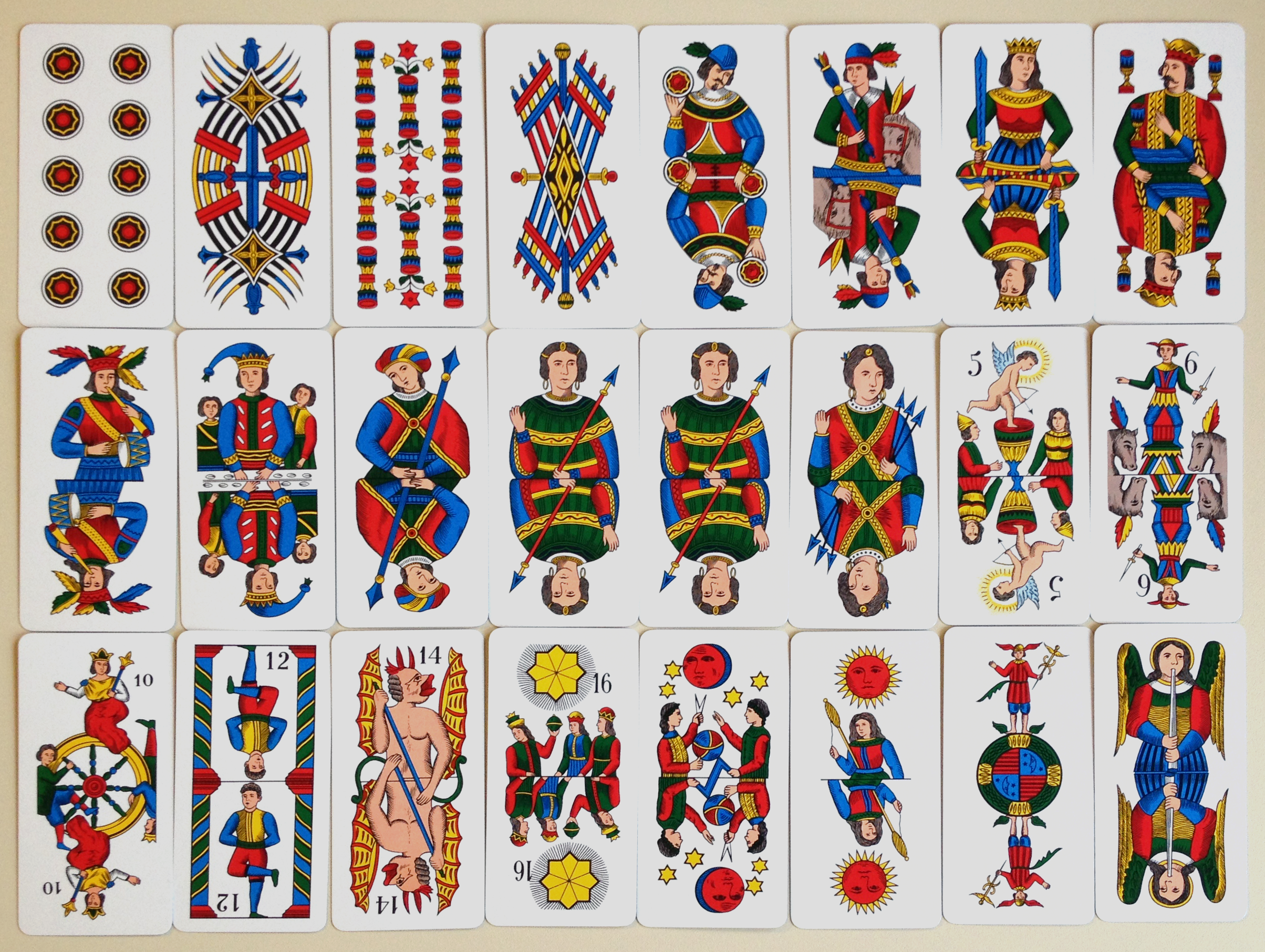|
Husarln
Husarln ("Hussar") is a mid-20th century, three-hand card game of the Austrian branch of the Tarot family. It is a 42-card variant of Illustrated Tarock and appears to be a close Austrian relative of the 42-card Hungarian tarock card games. The game is dominated by the distribution of Tarocks, giving it a "brisk and energetic feel" that is reflected in its name. It is also known as Block Tarock, although that name was given to a quite different and older game. History and etymology Husarln is one of a family of classical Austrian card games known as Tarock games; so much so, that the area of the former Austro-Hungarian Empire, in which they have a strong tradition, has been described as 'Tarockania'.''Tarockania'' at web.archive.org. Retrieved 19 September 2020. These games have been featured in literatur ... [...More Info...] [...Related Items...] OR: [Wikipedia] [Google] [Baidu] |
Tarock Card Games
Tarot games are card games played with tarot decks, that is, decks with numbered permanent Trump (card games), trumps parallel to the Playing card suit, suit cards. The games and decks which English-speakers call by the French name Tarot are called Tarocchi in the original Italian, Tarock in German and various similar words in other languages. The basic rules first appeared in the manuscript of Martiano da Tortona, written before 1425. The games are known in many variations, mostly cultural and regional. Tarot games originated in Italy, and spread to most parts of Europe, notable exceptions being the British Isles, the Iberian peninsula, and the Balkans.David Parlett, ''Oxford Dictionary of Card Games'', pg. 300 Oxford University Press (1996) They are played with decks having four ordinary suits, and one additional, longer suit of tarots, which are always trump (card games), trumps. They are characterised by the rule that a player who cannot follow to a trick with a card of the ... [...More Info...] [...Related Items...] OR: [Wikipedia] [Google] [Baidu] |
Illustrated Tarock
Illustrated Tarock (german: Illustriertes Tarock) or Illustrated Dreiertarock is an Austrian card game that has been described as the "queen" of all three-handed Tarock games played with the 54-card pack. It was thought by Mayr and Sedlaczek to be extinct but, in 2009 when the two Tarock authors were guests on an ORF radio programme, players from Vienna called in who confirmed they still played the game. It is sometimes called Point Tarock which, however, is a different, probably extinct, game, albeit a close cousin. Although it has "a reputation for being a little more convoluted than the others", Furr maintains that this is not so, but recommends that players become familiar with Tapp Tarock before attempting this game. History and etymology Illustrated Tarock is one of a family of classical Austrian card games known as Tarock games; so much so, that the area of the former Austro-Hungarian Empire, in which they have a strong tradition, has been described as 'Tarockania'. [...More Info...] [...Related Items...] OR: [Wikipedia] [Google] [Baidu] |
Tarot Card Games
Tarot games are card games played with tarot decks, that is, decks with numbered permanent trumps parallel to the suit cards. The games and decks which English-speakers call by the French name Tarot are called Tarocchi in the original Italian, Tarock in German and various similar words in other languages. The basic rules first appeared in the manuscript of Martiano da Tortona, written before 1425. The games are known in many variations, mostly cultural and regional. Tarot games originated in Italy, and spread to most parts of Europe, notable exceptions being the British Isles, the Iberian peninsula, and the Balkans.David Parlett, ''Oxford Dictionary of Card Games'', pg. 300 Oxford University Press (1996) They are played with decks having four ordinary suits, and one additional, longer suit of tarots, which are always trumps. They are characterised by the rule that a player who cannot follow to a trick with a card of the suit led ''must'' play a trump to the trick if possible. T ... [...More Info...] [...Related Items...] OR: [Wikipedia] [Google] [Baidu] |
Kosakeln
Kosakeln ("Cossack") is a relatively recent, two-hand card game of the Austrian branch of the Tarock (card games), Tarock family. It is a two-handed version of the three-player game of Illustrated Tarock, itself an elaborate and challenging variant of Tapp Tarock. History and etymology Kosakeln is one of a family of classical Austrian card games known as Tarock games; so much so, that the area of the former Austro-Hungarian Empire, in which they have a strong tradition has been described as 'Tarockania'.''Tarockania'' at web.archive.org. Retrieved 19 September 2020. These games have been featured in literature such as Fritz von Herzmanovsky-Orlando, Herzmanovsky-Orlando's ''Maskenspiel der Genien'' and Johann Nestroy's ''Zu ebener Erde und im ersten Stock''. There are numerous variations of Tarock, many s ... [...More Info...] [...Related Items...] OR: [Wikipedia] [Google] [Baidu] |
Tarock Game
Tarot games are card games played with tarot decks, that is, decks with numbered permanent trumps parallel to the suit cards. The games and decks which English-speakers call by the French name Tarot are called Tarocchi in the original Italian, Tarock in German and various similar words in other languages. The basic rules first appeared in the manuscript of Martiano da Tortona, written before 1425. The games are known in many variations, mostly cultural and regional. Tarot games originated in Italy, and spread to most parts of Europe, notable exceptions being the British Isles, the Iberian peninsula, and the Balkans.David Parlett, ''Oxford Dictionary of Card Games'', pg. 300 Oxford University Press (1996) They are played with decks having four ordinary suits, and one additional, longer suit of tarots, which are always trumps. They are characterised by the rule that a player who cannot follow to a trick with a card of the suit led ''must'' play a trump to the trick if possible. T ... [...More Info...] [...Related Items...] OR: [Wikipedia] [Google] [Baidu] |
Sküs
The trull is a trio of three special trump cards used in tarock games in Austria and other countries that have a much higher card value than the other trumps. The individual cards are known as trull cards (''Trullstücke''). The word ''trull'' is derived from the French ''tous les trois'' which means "all three". In spite of its French roots the term is not common in the game of French tarot, where the trull cards are called ''les bouts'' ("butts", "ends") or, in earlier times, ''les oudlers'', which has no other meaning. Introduction The games of the tarot (French) or tarock (German) family are distinguished mainly in that, in addition to the suit cards, their decks have a series of 21 classical, permanent trumps, most of which are numbered with Roman or Arabic numerals. In games of German-language origin the trumps are also called ''tarocks''. The special role of the 'fool' (''Narren'') is described below. Tarock games are trick-taking card games, in which the cards hav ... [...More Info...] [...Related Items...] OR: [Wikipedia] [Google] [Baidu] |
Robert Sedlaczek
Robert Sedlaczek (born 1952) is an Austrian journalist, Germanist and non-fiction author.Entry for Robert Sedlaczek in the catalogue of the German National Library (DNB). Retrieved 2 August 2020. He is best known for his works on aspects of the German language. In addition, he writes books and articles on cultural history topics. In his book ''Die Tante Jolesch und ihre Zeit. Eine Recherche'' he traced the history of the industrial family of the same name as well as the lawyer, Hugo Sperber. These people are characters in 's book ''Die Tante Jolesch''. Life Robert Sedlaczek was born 2 April 1952 in |
Habsburg Monarchy
The Habsburg monarchy (german: Habsburgermonarchie, ), also known as the Danubian monarchy (german: Donaumonarchie, ), or Habsburg Empire (german: Habsburgerreich, ), was the collection of empires, kingdoms, duchies, counties and other polities that were ruled by the House of Habsburg, especially the dynasty's Austrian branch. The history of the Habsburg monarchy can be traced back to the election of Rudolf I as King of Germany in 1273 and his acquisition of the Duchy of Austria for the Habsburg in 1282. In 1482, Maximilian I acquired the Netherlands through marriage. Both realms passed to his grandson and successor, Charles V, who also inherited the Spanish throne and its colonial possessions, and thus came to rule the Habsburg empire at its greatest territorial extent. The abdication of Charles V in 1556 led to a division within the dynasty between his son Philip II of Spain and his brother Ferdinand I, who had served as his lieutenant and the elected king of Hungary and ... [...More Info...] [...Related Items...] OR: [Wikipedia] [Google] [Baidu] |
Pip Card
Pip, PIP, Pips, PIPS, and ''similar'', may refer to: Common meanings * Pip, colloquial name for the star(s) worn on military uniform as part of rank badge, as in the British Army officer rank insignia or with many Commonwealth police agencies * The seed of some fruits * Pip (counting), a small but easily countable item, such as the dots on dice or symbols on playing cards ** Pip (dominoes), a dot on a domino tile Arts, entertainment and media * "Pip" (''South Park''), a 2000 episode of ''South Park'' * The Pips, the backup singers in the musical group Gladys Knight & the Pips * Providence Initiative for Psychogeographic Studies, an art group * PiP Animation Services, a Canadian animation studio * The Pip, the nickname of a clandestine radio station of Russian origin * BBC Pips or ''The Pips'', a timing signal broadcast by the BBC Finance and management * Percentage in point, a currency exchange rate fluctuation * Performance improvement plan, a management technique * Personal ... [...More Info...] [...Related Items...] OR: [Wikipedia] [Google] [Baidu] |
Hungarian Tarok
The Tarock card game family is represented in Hungary by a variant for four players that uses a 42-card deck, variously called Hungarian Tarock ( hu, Húszashívásos tarokk), Hungarian Tarokk or Paskievics (german: Paskiewitsch in Austrian sources). According to McLeod "interest in this fine game may again be increasing."''Hungarian Tarokk'' at . Retrieved 1 August 2021. Names and history According to research by experts, Hungarian Tarock originated in the 19th century from a variant of the Austrian game, |
Hearts (card Suit)
Hearts (french: Cœur, german: Herz) is one of the four suits in playing cards of both the French deck and the German deck. However, the symbol is slightly different: in a French deck and in a German-suited deck. In Bridge, for which in Germany the French deck is common, it is called by its French name, ''Cœur''. In games using German-suited cards the suit of Hearts is often called "Red" (''Rot''). In the game of Watten, the King of Hearts is the highest Trump. This suit was invented in 15th century Germany and is a survivor from a large pool of experimental suit signs created to replace the Latin suits. Name The origin of the term "heart" to describe the symbol, which only very marginally resembles a true heart, is not known. In general, equivalents in other languages also mean "heart". File:Bay herz.svg, The heart in German suited cards File:Naipe copas.png, The heart in French suited cards Characteristics The heart typically has a form of cardioid, the lower par ... [...More Info...] [...Related Items...] OR: [Wikipedia] [Google] [Baidu] |



